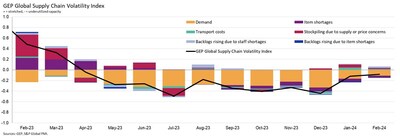Published on: Thursday, 14 March 2024 ● 5 Min Read
CLARK, N.J., March 14, 2024 -- The GEP Global Supply Chain Volatility Index — a leading indicator tracking demand conditions, shortages, transportation costs, inventories and backlogs based on a monthly survey of 27,000 businesses — rose further in February. While global supplier capacity is still underutilized, the index increased to -0.08, from -0.12 in January, its highest in 10 months. After nearly a year of declining supplier activity, capacity pressures have begun building again.

Global demand for raw materials, commodities and components also showed signs of recovery in February after a nearly two-year period of decline due to destocking and high inflation. Input demand was stable in Asia, signaling restocking and economic resilience across the region. Similarly, evidence of inventory building in North America suggests the continent's manufacturers are preparing for growth. In fact, capacity at suppliers to North America was stretched for the first time since March 2023, with backlogs ticking higher as a consequence.
Notably, we continue to see evidence that the Red Sea attacks have had a negligible impact on global supply chains. The most visible effect was an uptick in transportation costs in January, but global logistics costs fell during February.
"Globally in February, we saw supply chains being more utilized, suppliers are busier, and input demand and manufacturing are turning a corner after nearly a year of low-capacity utilization," explained Mukund Acharya, vice president, consulting, GEP. "Suppliers to North America were the busiest globally last month, spurred by the Inflation Reduction Act and Bipartisan Infrastructure Law driving economic activity in construction, semi-conductors, and renewables."
Interpreting the data:
FEBRUARY 2024 KEY FINDINGS
REGIONAL SUPPLY CHAIN VOLATILITY
For more information, visit www.gep.com/volatility.
The next release of the GEP Global Supply Chain Volatility Index will be 8 a.m. ET, April 12, 2024.
About the GEP Global Supply Chain Volatility Index
The GEP Global Supply Chain Volatility Index is produced by S&P Global and GEP. It is derived from S&P Global's PMI® surveys, sent to companies in over 40 countries, totaling around 27,000 companies. The headline figure is a weighted sum of six sub-indices derived from PMI data, PMI Comments Trackers and PMI Commodity Price & Supply Indicators compiled by S&P Global.
For more information about the methodology, click here.
Full historical data dating back to January 2005 is available for subscription. Please contact economics@spglobal.com.
About GEP:
GEP® delivers AI-powered procurement and supply chain solutions that help global enterprises become more agile and resilient, operate more efficiently and effectively, gain competitive advantage, boost profitability and increase shareholder value. Fresh thinking, innovative products, unrivaled domain expertise, smart, passionate people — this is how GEP SOFTWARE™, GEP STRATEGY™ and GEP MANAGED SERVICES™ together deliver procurement and supply chain solutions of unprecedented scale, power and effectiveness. Headquartered in Clark, New Jersey, GEP has offices and operations centers across Europe, Asia, Africa and the Americas. To learn more, visit www.gep.com.
About S&P Global: S&P Global (NYSE: SPGI) S&P Global provides essential intelligence. To learn more, visit https://www.spglobal.com
Media Contacts | |
Derek Creevey | Joe Hayes |
Director, Public Relations | Principal Economist |
GEP | S&P Global Market Intelligence |
Phone: +1 732-382-6565 | T: +44-1344-328-099 |
Email: derek.creevey@gep.com |


Photo - https://mma.prnewswire.com/media/2362139/gep_index.jpg
Photo - https://mma.prnewswire.com/media/2362138/gep_index_2.jpg
Logo - https://mma.prnewswire.com/media/518346/GEP_Logo.jpg

No comments posted
© 2019 KIVAA Group | All right reserved. www.theindustrial.in
Leave a reply: